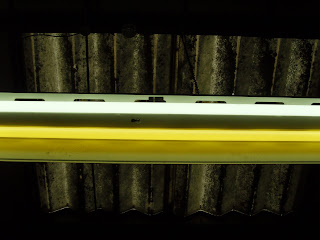
Blue Apron Transport (Fine Art) are a company that store, transport, install, pack and photograph art for Galleries, Private Collectors and Museums. It's a pretty quiet place, there arent big signs or anything it's quite discreet. My job is to help around in both the warehouse and on studio visits to collect or deliver art.

First off I was given a pair of steel toe capped boots, high vis vest and gloves. The boots I'll need all the time for safety, the vest for use on the truck or in the loading bay (but not in Galleries or Artist Studios), the gloves if I help handling cases. I had a safety talk on fire and on how to lift carefully. I'll always be working as part of a team so I've been told to only move the artworks with another person. That's not just me it's everyone because everything is so valuable and often very fragile. Later I went out in a truck to the studio of the artist Eileen Cooper.

She's a painter, (see above), we delivered three works (canvases on stretchers she had stored in the warehouse) to her studio, which is part of her house. Lester, an art student working at Blue Apron showed me how to tie off the painting in the truck. It's important not to damage the work which was wrapped in plastic. A Blanket went over the face, then one end of the tie is tied to the rails on the side of the truck, pulled across the picture then tied around another rail, There's a special knot which I'll try to get a shot of on another day. You have to watch the other person all the time so you lift in the same way. No one does anything in a hurry. The only obstacle was Eileens dog.

In the afternoon I worked in the warehouse. We had to locate works for delivery and collection next day. Everything is logged on a database with descriptions of the work and the packaging. Everything has a number. Different works need different types of packaging, some are only plastic and acid free tissue, some are in heavy wooden or metal cases. Mostly the cased works are travelling to other countries orwill be going on long truck journeys as part of a large load.
We listed the works and made out the collection and delivery notes, then logged the works out on the database.

Another artists work I saw was Tessa Farmers 'Swarm'. I didn't see it installed, although it was set up here last week for the Saatchi Gallery to test in a new case and photograph. It's made up of dried out bees and dragonflys with tiny winged skeletons riding on their backs. They normally hang from threads but now they're attached to a perspex sheet for transport. I'll be helping to make the box for them later in the week. One of the guys told me the artist is coming back when the flying ants come out in Bermondsey, she's going to collect the dead ones for new work.

The warehouse spaces have to be kept clear and are regularly tidied up and works put away in racks. I think first off tomorrow I'll be helping the guys clear up.





























